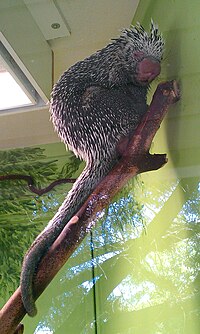The prehensile-tailed porcupines or coendous (genus Coendou) are found in Central and South America.[2] Two other formerly recognized Neotropical tree porcupine genera, Echinoprocta[3] and Sphiggurus,[4] have been subsumed into Coendou, since Sphiggurus was shown by genetic studies to be polyphyletic, while Echinoprocta nested within Coendou.[5]
| Prehensile-tailed porcupines Temporal range: Early Pleistocene to Recent[1]
| |
|---|---|

| |
| Coendou prehensilis | |
| Scientific classification | |
| Domain: | Eukaryota |
| Kingdom: | Animalia |
| Phylum: | Chordata |
| Class: | Mammalia |
| Order: | Rodentia |
| Family: | Erethizontidae |
| Subfamily: | Erethizontinae |
| Genus: | Coendou Lacépède, 1799 |
| Type species | |
| Hystrix prehensilis | |
| Species | |
|
See text | |
Characteristics
editAmong the most notable features of Coendou porcupines are their unspined prehensile tails. The front and hind feet are also modified for grasping. These limbs all contribute to making this animal an adept climber, an adaptation to living most of their lives in trees.[6]
They feed on leaves, shoots, fruits, bark, roots, and buds. They can be pests of plantation crops.[6] They also make a distinctive "baby-like" sound to communicate in the wild.
Their young are born with soft hair that hardens to quills with age. Adults are slow-moving and will roll into a ball when threatened and on the ground. The record longevity is 27 years.[7]
Species
edit- Genus Coendou - prehensile-tailed porcupines[5]
- Baturite porcupine - C. baturitensis - a newly discovered species[8][9][10]
- Bicolored-spined porcupine - C. bicolor
- Streaked dwarf porcupine - C. ichillus
- Bahia porcupine - C. insidiosus
- Black-tailed hairy dwarf porcupine - C. melanurus
- Mexican hairy dwarf porcupine - C. mexicanus
- Black dwarf porcupine - C. nycthemera
- Amazonian long-tailed porcupine - C. longicaudatus
- Brazilian porcupine - C. prehensilis
- Frosted hairy dwarf porcupine - C. pruinosus
- Andean porcupine - C. quichua
- Roosmalen's dwarf porcupine - C. roosmalenorum
- Stump-tailed porcupine - C. rufescens
- Santa Marta porcupine - C. sanctamartae
- C. speratus - a newly discovered species[11]
- Paraguaian hairy dwarf porcupine - C. spinosus
- Brown hairy dwarf porcupine - C. vestitus
References
edit- ^ "Coendou in the Paleobiology Database". Fossilworks. Retrieved 2019-03-09.
- ^ Woods, C.A.; Kilpatrick, C.W. (2005). "Genus Coendou". In Wilson, D.E.; Reeder, D.M (eds.). Mammal Species of the World: A Taxonomic and Geographic Reference (3rd ed.). Johns Hopkins University Press. pp. 1546–1547. ISBN 978-0-8018-8221-0. OCLC 62265494.
- ^ Woods, C.A.; Kilpatrick, C.W. (2005). "Genus Echinoprocta". In Wilson, D.E.; Reeder, D.M (eds.). Mammal Species of the World: A Taxonomic and Geographic Reference (3rd ed.). Johns Hopkins University Press. pp. 1547–1548. ISBN 978-0-8018-8221-0. OCLC 62265494.
- ^ Woods, C.A.; Kilpatrick, C.W. (2005). "Genus Sphiggurus". In Wilson, D.E.; Reeder, D.M (eds.). Mammal Species of the World: A Taxonomic and Geographic Reference (3rd ed.). Johns Hopkins University Press. pp. 1548–1550. ISBN 978-0-8018-8221-0. OCLC 62265494.
- ^ a b Voss, R. S.; Hubbard, C.; Jansa, S. A. (February 2013). "Phylogenetic Relationships of New World Porcupines (Rodentia, Erethizontidae): Implications for Taxonomy, Morphological Evolution, and Biogeography" (PDF). American Museum Novitates. 3769 (3769): 1–36. doi:10.1206/3769.2. S2CID 55426177.
- ^ a b Nowak 1999
- ^ Gorbunova, Bozzella & Seluanov 2008
- ^ Feijó, Anderson; Langguth, Alfredo (2013-09-12). "A new species of porcupine from the Baturité range". Revista Nordestina de Biologia. 22 (1/2): 124–126.
- ^ "New Discovery: Porcupine Species Identified in Brazil". National Geographic. 2013-12-10. Archived from the original on December 13, 2013. Retrieved 2013-12-20.
- ^ "Coendou baturitensis: New Porcupine Discovered in Brazil". Sci-News.com. 2013-12-02. Retrieved 2013-12-20.
- ^ Pontes, A.R.M.; Gadelha, J.R.; Melo, É.R.A.; SÁ, F.B.; Loss, A.C.; Caldara Jr, V.; Costa, L.P.; Leite, Y.L.R. (2013-04-05). "A new species of porcupine, genus Coendou (Rodentia: Erethizontidae) from the Atlantic forest of northeastern Brazil" (PDF). Zootaxa. 3636 (3): 421–438. doi:10.11646/zootaxa.3636.3.2. PMID 26042302.
- Gorbunova, V; Bozzella, MJ; Seluanov, A (September 2008). "Rodents for comparative aging studies: from mice to beavers". Age (Dordr). 30 (2–3): 111–119. doi:10.1007/s11357-008-9053-4. PMC 2527635. PMID 19424861.
- Nowak, Ronald M (1999). Walker's Mammals of the World (6th ed.). Johns Hopkins University Press. ISBN 0-8018-5789-9.
- Woods, C.A.; Kilpatrick, C.W. (2005). "Infraorder Hystricognathi". In Wilson, D.E.; Reeder, D.M (eds.). Mammal Species of the World: A Taxonomic and Geographic Reference (3rd ed.). Johns Hopkins University Press. pp. 1538–1599. ISBN 978-0-8018-8221-0. OCLC 62265494.